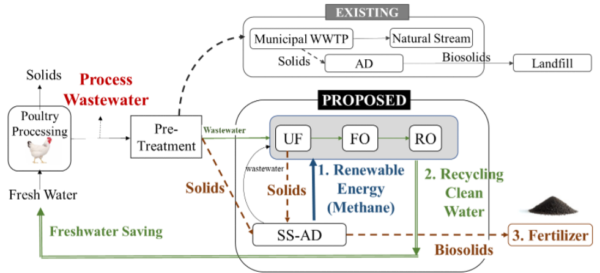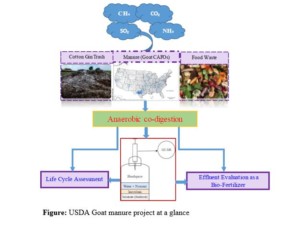Project: Excellence in Research: A Novel High Throughput Forward Osmosis Membrane for Produced Water Treatment, Kommalapati, Reeves and Shafer (UH), National Science Foundation, 08/19-07/22, $500,000
The goal of the proposed research is to develop a novel method for treating shale gas and oil produced water (PW) that employs a novel high throughput forward osmosis (FO) membrane with significantly improved antifouling and reverse draw solute repelling properties. The proposed high throughput FO membrane consists of a nanofibrous support layer, a thin coating layer at the bottom of the support layer, and an ultrathin active layer. A graphene oxide (GO)-embedded polyetherimide nanofibrous substrate will be fabricated and used as the support layer, and the bottom of the support layer will be modified with the zwitterionic polymer, 2-methacryloyloxyethyl phosphorylcholine (MPC). The ultrathin active layer will be synthesized at low temperature with phase conversion, and its top will be coated with zwitterionic sulfobetaine methacrylate (SBMA). To obtain clean product water, a conventional reverse osmosis (RO) process will be integrated with FO filtration to form a hybrid FO-RO process. After fabrication and characterization, the novel membrane will be tested in the FO filtration system. A mixed ammonia-carbon dioxide draw solute will be used in the FO filtration process to take advantage of the availability of recycling options by using low-grade waste heat or thermal energy collected with a solar heater. The water produced from the final RO process will be tested for comparison with environmental disposal standards. The repelling and antifouling mechanisms will be elucidated through molecular dynamics simulations. The economic and environmental impacts of the hybrid FO-RO process for shale gas and oil PW treatment will be evaluated using a life cycle assessment approach.
Figure: Schematic of a proposed PW treatment process
Project: Zero-Waste Poultry Processing with Sequential Membrane Separation and Anaerobic Digestion, Kommalapati, Du, Awal (PVAMU) and C. Coufal (TAMU), US Department of Agriculture, 05/20-04/23, $500,000
Poultry processing requires large quantities (98 billion gal/year) of fresh water for sanitizing the equipment and cleaning the meat, resulting in process wastewater (PPW) contaminated with blood, lipids, protein and feces. The continuously increasing production of poultry meat in USA, inflicts severe strain on depleting fresh water resources and burden on municipal wastewater treatment plants (WWTP). Conventional WWTP are not capable of removing trace levels of emerging contaminants and high levels of nitrogen and phosphorus (nutrients) present in PPW. We propose to address the dual challenge of sustainability and food safety of poultry processing with a novel zero-waste approach to handling PPW and biosolids separated from processing water. In our proposed project, PPW will be treated with an innovative sequential ultrafiltration, forward & reverse osmosis (UF-FO-RO) system and the solid waste separated from PPW pretreatment will undergo 2-stage solid state anaerobic digestion (SS-AD) to prdouce renewable energy methane and fertilizer as by-product. The clean water obtained from sequential membrane process will be recycled back to the poultry processing stage, and the renewable methane generated from SS-AD will partially cover energy requirement of the membrane process. Our proposed goal of attaining zero-waste poultry processing to improve food safety and sustainability during poultry processing addresses key areas of ecological/environmental concerns such as: (1) depleting freshwater resources, (2) spread of foodborne contaminants via inefficiently treated wastewater, (3) rising operating costs of poultry processing plants and (4) growing nutrient pollution in watersheds.
Figure: Existing and proposed process wastewater handling system in poultry processing
Project: Systems-Based Integrated Program for Enhancing The Sustainability of Antibiotic-Restricted Poultry Production, USDA, Univ. of Connecticut, – Prairie View A&M (Sub-award), Kommalapati, 09/20-09/24, $450,000.
The description of the entire project can be found at the link: National Institute of Food Agriculture
Scope of the Work in the Center for Energy and Environmental Sustain Prairie View A&M University as follows
1. The scope of the work will cover two objectives: Bird Welfare, and Sustainable Poultry Litter Recycling and Management
2. An on-farm instrument shelter (OFIS) or mobile laboratory will be set up to monitor air pollutants in/outside a poultry house by using air pollutant analyzers NH3, NOx, H2S, CO, CO2, volatile organic carbons (VOCs), PM10 and PM2.5. Besides air pollutants, indoor temperature, humidity, airflow circulating rate and air exchange with house ventilation system will also be monitored continuously;
3. Environmental impacts of supercapacitor (SC) electrodes produced from poultry litter will be investigated by using life cycle assessment;
4. Life cycle assessment of meat/egg production from cradle to retailer in different geographical regions in the U.S.
The air quality monitoring work will be conducted in a poultry house in Arkansas, and the participating faculty from the University of Arkansas will assign Dr. Kommalapati to conduct air quality monitoring in the poultry house that they find. During air quality monitoring, we will NOT touch the poultry in the houses, just detect air pollutant levels of the poultry houses by using gas analyzers. We DO need to set up the gas analyzer shelter in the poultry house by entering the house. The life cycle assessment (LCA) work only needs a computer installed LCA software to complete the simulation work, and there no poultry house access needed.
Project: Potential Use of Renewable Diesel for Transportation in Texas and its Environmental Impacts. USDOT- LSU Tran-SET, Kommalapati, Du, and Alam, 08/21-01/23, $60,000
Compared to biodiesel, renewable diesel is a relatively new biofuel that can also be used for diesel vehicles. Some advantages of renewable diesel over biodiesel are no special requirements for the vehicle, cold startup, and fuel storage. There is no renewable diesel plant in Texas, and no action is being considered on renewable diesel application for Texas’ transportation. The proposed project would address this critical gap and develop environmental life cycle and cost assessments to produce renewable diesel in Texas and its local applications in transportation. A novel and key component of this work would be the development of a decision-making tool that would help determine where the renewable diesel processing plant should be built. Life cycle emissions of renewable diesel used for short-haul and long-haul trucking in Texas will be evaluated with the GREET model, a life cycle assessment (LCA) tool. Life cycle cost analysis (LCCA) of renewable diesel production in Texas will also be carried out with the consideration for some uncertainties of seasonal bioresource availability, transportation, and fuel production. The decision-making tool developed in this study would help the biofuel industry to make the decision on the development of renewable diesel in Texas. Faculty working on this research will integrate LCA as an important focus area for all senior and graduate-level civil and environmental engineering courses. These students will also be introduced to the techniques of well-to-wheel analysis and production cost evaluation for renewable fuels.
Figure: The system boundary and key stages of renewable diesel used in transportation
Energy and Nutrient Recovery from Goat Manure by Anaerobic Co-Digestion with Cotton Gin Trash and Food Waste, Kommalapati, Botlaguduru, Awal; US Department of Agriculture; 02/18-02/22, $300, 000
The overarching goal of the project is to develop an integrated waste management solution via anaerobic co-digestion of goat manure with cotton gin trash and food waste to recover methane and nutrient-rich biosolids. At the optimized concentrations of chemical additives such as fly ash and MgCl2; the efficacy of a two-stage temperature phased anaerobic co-digestion process, its kinetic parameters, struvite recovery, and the effluent evaluation studies are profound steps towards new process designs and serve as a benchmark of the research efforts at the NSF CREST Center for Energy and Environmental Sustainability at Prairie View A&M University. Several more feedstocks were introduced in the later stages of the project. At its completion the research will help to improve the performance of digesters at goat CAFOs by incorporating cotton gin trash, food waste another agro-wastes thus adding to the renewable energy resources taking care of the environment-related concerns arising from manure mismanagement. It will enhance the farmer’s income while adding to the renewable energy inventory of the southwest United States.




